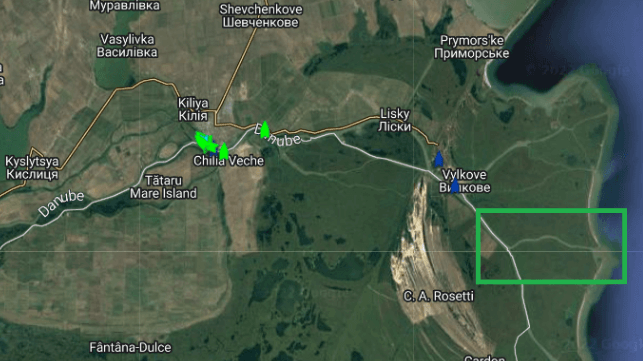Romanian Gov't Irked by Ukrainian Dredging on Danube Delta Canal

After Ukraine's ministry of infrastructure announced that the allowable draft in the Danube's Bystroe Canal has been deepened by nearly nine feet, the government of neighboring Romania has asked for a formal explanation about whether Ukraine has been conducting unpermitted dredging in an environmentally protected wetland.
The northernmost branch of the Danube River delta (the Kiliysky Estuary) follows Ukraine's southern border. This channel is lined with a series of small ports on the Ukrainian side. Now that Russia restricts Ukraine's Black Sea commerce, these historically-underused riverine terminals have taken on a new importance. The area can be reached by two waterways: the narrow Sulina Canal through Romanian territory, and the Bystroe (also translated as Bystry, Bystre or Bystroye) Canal, which passes through Ukrainian territory.
The Bystroe was originally dredged to a depth of 15 feet during construction, and in recent years its allowable draft has been about 13 feet, according to Ukrainian officials. However, for reasons unclear, it is now able to accommodate much deeper hulls. On Friday, Ukraine's Ministry of Restoration announced that the allowable draft of shipping through the canal has increased to more than 21 feet, comparable to the navigable depth of Romania's Sulina Canal.
“This is the first time we have been able to increase the allowable draught of vessels under independent Ukraine. Thanks to this we will be able to provide more efficient and safe navigation between the Black Sea and the Danube River, as well as increase the cargo flow through the Danube ports,” said Minister of Reconstruction Alexander Kubrakov.
Romania's government has expressed serious concern that Ukraine may have been conducting a capital dredging project in a sensitive shared ecological zone. The Bystroe Canal passes through the Danube Delta Transboundary Biosphere Reserve, the largest natural wetland in Europe. Romania's ministry of foreign affairs said last week that it had not received any communication from the Ukrainian side about deepening of the Bystroe. On Monday, Romanian minister of external affairs Bogdan Aurescu said that he had pulled aside his Ukrainian counterpart, Dmitro Kuleba, to ask for clarification while the two were attending the Munich security conference.
The Ukrainian embassy in Bucharest released a statement Saturday asserting that the dredging in the Bystroe Canal is solely for maintenance and is carried out only within the national borders of Ukraine.

that matters most
Get the latest maritime news delivered to your inbox daily.
"In the event that the Ukrainian side will plan the implementation of major projects different from the current operational ones, the Romanian side will be informed in advance," the embassy said. "[We] urge the responsible advancement of public information in order not to harm bilateral relations and not to feed Russian propaganda."
Romania opposes the inclusion of Ukraine's Bystroe Canal and the adjacent Chilia estuary in the EU's Trans-European Transport Network (TEN-T), a set of designated routes eligible for EU infrastructure funding. Ukraine has requested that the waterway be listed as a TEN-T route, parallel to Romania's Sulina Canal.
